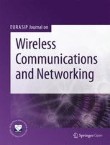2022 Citation Impact
2.6 - 2-year Impact Factor
2.5 - 5-year Impact Factor
1.098 - SNIP (Source Normalized Impact per Paper)
0.985 - SJR (SCImago Journal Rank)
2023 Speed
23 days submission to first editorial decision for all manuscripts (Median)
157 days submission to accept (Median)
2023 Usage
1,226,841 downloads
99 Altmetric mentions
